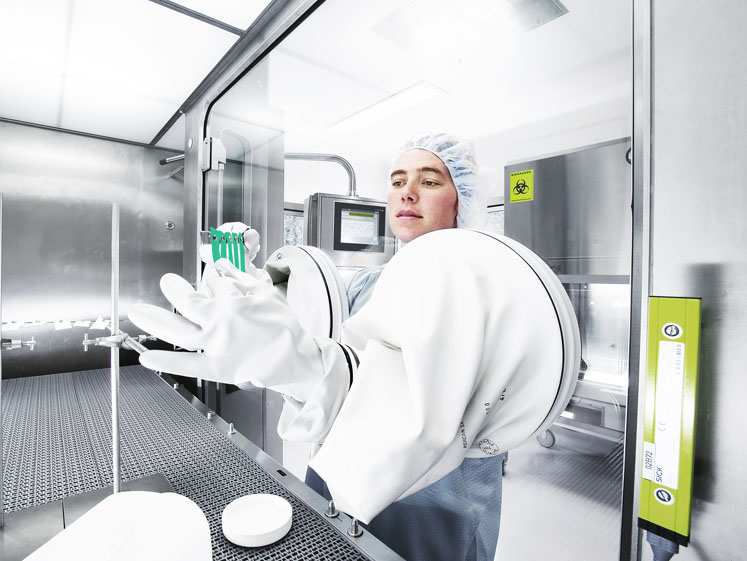To ensure that barrier systems are sterile and processes remain safe, a thorough and regular inspection of glove integrity is vital. The regulatory requirements for gloves are strict. However, they also leave plenty of choice regarding suitable test methods. Many facility operators struggle to ascertain which method is best suited for which system.
The demand for barrier systems such as isolators and RABS (restricted access barrier systems) is increasing apace all over the world. One reason is the growing demand for biopharmaceuticals, — biotechnologically manufactured drugs — that promise groundbreaking treatment options in immunotherapy or in the fight against cancer.
However, the production of these highly effective and, therefore, highly potent drugs requires special safety precautions and hermetically sealed production facilities to adequately protect humans and pharmaceuticals from each other. Manual work within the barrier systems is only possible thanks to glove ports.
They can be used to take samples, eliminate malfunctions or exchange components. The gloves, which are only tenths of a millimetre thick, are the most critical interfaces in isolators and RABS — and must be prevented from turning into a weak point in the overall system.
Glove testing: a must without defined guidelines
A defective glove poses a major risk to the integrity of the barrier system. Even the smallest hole in the glove’s thin material can lead to the contamination of the pharmaceutical product or expose the operator to dangerous substances. Therefore, the glove ports of isolators and RABS must meet strict regulatory requirements.
The US Food and Drug Administration (FDA), for example, stipulates that only gloves made of long-lasting, durable materials are to be used and replaced on a regular basis. In addition, employees should visually inspect gloves for damage before each use, and physical tests should be performed routinely. Similar standards are established in the EU Directive on Good Manufacturing Practice (GMP).
The main challenge is that pharmaceutical manufacturers need to define their own standard operating procedures (SOPs) for glove testing according to these directives and set up an appropriate procedure for their facilities on a risk analysis basis.
It is up to them to define the method and frequency of their glove port tests. The possibilities are manifold. However, not every test method is equally suited for all barrier systems, as both the gloves and the methods have to meet different requirements for isolators and RABS.
Different requirements for isolators and RABS
Gloves for RABS are slipped over the opening of the glove port and removed for cleaning: a manual process requiring special care to avoid damaging the glove. The cleaning of RABS gloves is also done manually, with subsequent sterilisation taking place in an autoclave.

Matthias Angelmaier
As this repeated handling and sterilising of the gloves has a strong impact on their material, RABS gloves consist of extremely robust and heat-resistant materials such as EPDM rubber. In addition, RABS and their surrounding cleanrooms are increasingly treated with hydrogen peroxide (H2O2) for decontamination, which is why the gloves also have to be H2O2-resistant.
The high degree of material wear requires the testing of RABS gloves to be particularly thorough to ensure the integrity of the overall system. In fact, the integrity and testing of RABS gloves has become increasingly critical during the last few years.
Testing can be done both inline and offline on the removed glove. Offline tests are particularly advantageous for large systems with many glove ports: the cleaning and testing processes can partly be done in parallel to save valuable time.
Gloves for isolators are usually cleaned inline as part of the changeover process between production batches. For this purpose, the gloves remain in their ports, where they are precleaned manually by the operator. The gloves are then also decontaminated during the H2O2 decontamination of the isolator.
H2O2-resistant materials such as EPDM rubber or the less cost-intensive chlorosulfonated polyethylene (CSM) are therefore essential for isolator gloves. As the gloves usually remain in the production line permanently, testing also takes place inline. Ergonomic characteristics and accessibility play an important role to make testing as efficient as possible.
Test methods at a glance
An important element of glove testing is visual inspection by trained machine operators before each use, detecting both large and small impairments to the glove with their naked eye. To identify microscopic leaks, various test methods can be used. To cite a simple example, gloves are hung up and filled with water.
If water escapes from the glove, it must be disposed of. Similarly, a chemical can be applied to one side of the glove as part of a chemical diffusion test. If the chemical permeates, the glove is damaged. However, these test methods come from laboratory environments and are not suitable for modern aseptic manufacturing facilities, as the units — including their barrier systems as well as the surrounding areas — would be contaminated with water and chemicals.
The pressure holding test, by contrast, offers a more reliable way to detect even the slightest defects and smallest leaks: the glove is pressurised (to 600 Pa) for a certain amount of time. The air volume per time required to compensate for pressure loss owing to possible glove damage is measured using a flow meter and then related to the leakage rate. However, this test method has a low reproducibility, as the measurement results are very sensitive to environmental conditions.
The pressure decay test
Developed by Syntegon Technology, formerly Bosch Packaging Technology, at the beginning of the 21st century, the pressure decay test ensures a higher level of reproducibility. It is currently the most commonly used physical test method and can be applied both inline for isolators and offline for RABS.
For the first time in a glove testing procedure, each glove is stretched several times before the pressure decay test begins. As such, each glove is tested under the same initial conditions regardless of its regular use and utilisation rate, which in turn ensures the reproducibility of the test results.

The glove system is subjected to a predefined test pressure. Here, it is crucial to define the appropriate parameters, leading to each glove type receiving an individually tailored test recipe. Applying too much or too little pressure might result in damage not being detected in certain areas of the glove.
Once a certain pressure level is reached, the pressure is repeatedly measured during a predefined period. If there are leaks in the glove, air can escape and the pressure will drop. This method is very accurate and able to detect holes/rips as small as a few micrometres. The test only takes 10–20 minutes, depending on the glove’s material and thickness.
Since its introduction about 10 years ago, the pressure decay test has become the most common test method in the pharmaceutical industry worldwide. Owing to its high degree of reproducibility and testing accuracy, it is particularly suited for regular glove testing.
Seamless glove management for safe barrier systems
Regardless of which test methods operators of barrier systems choose, whether they require inline or offline systems or whether they combine both methods, they all share the same need for efficient processes and seamless glove management from delivery to disposal. This includes the comprehensive tracking of processes such as cleaning, autoclaving, assembly and disassembly.
Fully inclusive documentation requires the integration of glove testing into the daily routine of line changeovers. Even if production systems without glove ports already exist for small batches and new facility concepts with fewer glove ports are being developed, they will remain an essential component of barrier systems for the foreseeable future. As such, they will continue to require special attention to ensure the safety and integrity of the overall barrier system.
